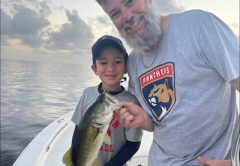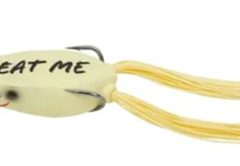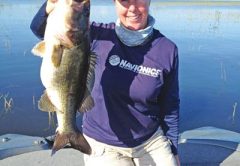Fishing a tournament is in many ways a mirror image of the planning strategies used for any fishing trip except there is appreciably more intensity. This is because you are not just focusing on your challenge of catching bass but also on how that performance will stack up on a given day with other very serious anglers. To make things work the best, you will establish priorities that emphasize certain facets of the fishing strategy you are going to follow.
As we will discuss some of these will change as you fish during the day while others consist of covering a number of items before you hit the lake. In fact some of the most serious anglers on the circuits prepare by keeping a written daily log of the facts they want to refer to in the future and religiously refer to this historical guide before they would consider fishing a tournament.
This base of data includes areas where fished, time of year, water temperature, wind, type of baits, as well as time of day and condition of sky (cloudy or clear). Folks that follow this kind of logging of information really take fishing to the level of a science. Since I do science for a living I don’t go into the formal recording of daily activity while on the lake, but I do make a mental note of where, when, and how I caught bass. All this is even further of value if you can take the information and begin to put some thoughts as to why the fish were likely where they were in the equation.
The first thing you need to ask about a lake before you decide to fish a tournament is what do you know about the lake? If the answer is everything then skip this section, while the rest of us mortals look at some resources we need to consider using.
Logically a good map is an excellent starting point, and a topo map, if available, is even better These tools are only as good as your ability to supplement them with some local information. If you know a friend who fishes the lake then use that resource. If not then start with calling a marina and ask if they would suggest a guide with whom you could discuss the status of bass fishing in general and the most important issue of the lake condition in general.
It is at this point that some folks decide to actually hire a guide (if tournament rules permit) to be shown the lake and even where to fish (if the guide agrees). I prefer to try to find my own fish and therefore succeed or fail on my merits, but this is clearly a personal choice. So if I were to seek local advice it would be in regard to the following:
- What is the lake level? Having a map is only as good as your ability to relate to the actual level of the lake when you are planning to fish it. Seeing the lake’s outline at normal pool level is greatly different than your interpretation from the map if you know that the lake is 40 feet low or 10 feet high, a good topo map can’t tell you that. It can however help you see the most logical contour lines that are still in the water and thus help you to reason where the bass may have migrated with the falling or rising water.
- What is the clarity of the lake- upper/lower/arms/main body, etc? This will certainly help me in determining the types of places I want to start searching for fish. For example I may want to find off-colored water or more stained water since I know fish will be shallower in such areas. Likewise the importance of recent runoff can affect small or large areas of the backups both in the level of water clarity as well as influence water temperature during certain times of the year.
- What is the lake temperature? This can be critical in determining fish movements in spring and fall where temperature in coves and the open lake vary greatly. Often this temperature will be a factor in the depth you will find concentrations of bass and this will influence the type of bait you may choose to fish.
- You can also ask what colors, and types of bait as well as the types of depth or structures the guides are finding productive without asking them to give away their spots.
- Finally if you really like to fish vegetation (and are lucky enough for the lake to have some), then you can save considerable time by asking what parts of the lake have growth.
So now is the time to start putting the information together into a strategy. You have the map and have gotten local information (if not then your only other pre-tournament option is a boat ride around the targeted arm of interest). Your choice of likely spots for tournament fishing should be tested in an attempt to give you as much information and flexibility as possible on tournament day.
For example an open-water spot may be great, but what if the wind gets high? Do you have fall back positions? Can you get to the fish from the launch site if it “comes a blow?” How much longer will it take to get there and how long to get back under such conditions? Macho boat driving is one thing, but hurting yourself or your partner is a whole other thing. Always watch the weather prior to a tournament. In the spring, winter, and fall you will at least know if a frontal passage is likely and with it a strong shift in the direction of the wind. This isn’t just for safety sake, but you may be forced to fish what the wind gives you on the more protected parts of the lake. If the front is likely to produce heavy rains several days before a tournament, don’t place all your bets on areas that might catch rapid runoff and muddy quickly.
SUCCESSFUL TOURNAMENT FISHING CAN BEST BE ACHIEVED THROUGH CAREFUL PRIOR PLANNING, PROPER USE OF EQUIPMENT, SELECTION OF MULTIPLE AREAS CONSIDERED AS PRODUCTIVE, AND AS MUCH FISHING VERSATILITY IN PRESENTATION AS YOU CAN FEEL COMFORTABLE.
Another important question that may seem a little silly is what type of fishing do you want to do? Most folks are better or at least have more confidence in some types of fishing than others. If you like to flip, use soft plastics, crankbaits, spoons, etc, then concentrate in areas that play to your strengths.
Shallow and deep water bass share similar common habits. These include being where there is food, cover, or unique structure such as channels or wood lines. So use your depth finder to determine if there is forage such as schools of shad in the areas that you previously selected based on what you have learned from the map review as well as the information you either inherited from local fisherman or from your own boat ride on the lake.
It is always a tough call as to how far you should ride from the launch site to your fishing holes. It is a proven fact that you aren’t going to catch a fish on the boat ride and the longer the ride the fewer casts you are going to get per tournament hour. It is also true that fishing close by in unproductive water isn’t going to win many tournaments either. One obvious advantage of getting reasonably away form the launch site is that you should fish bass that aren’t likely to get as much pressure from your competitors. This in itself is a real plus for me since I usually feel like I have a better chance when working areas that aren’t beaten up during practice.
Speaking of practice, try to work, but not over work an area. As hard as it might be, make every attempt to shake off a fish rather than hooking them. Also it is important to cover as many spots with as many baits as you feel gives you good preparation. You are trying to establish where the fish are and note the position in which they are holding. It may be hard to realize it, but it is also important to find out what they are not hitting. Better to learn this in practice than in a tournament.
It is also important to develop instincts as to what you are supposed to be doing. I drew a partner on Livingston once who thought that I had lost my mind since I kept going back to the one spot during my time for running the boat. I knew the school was there, or would be, at some point during the day. An hour before the weigh-in they arrived. It is amazing how a limit of good bass can make you suddenly look smarter than you really are. Oh, did I mention that the other intangible in tournament fishing or bass fishing in general is LUCK? Problem is, I seem to have to work hard to get lucky. But as the old Chinese saying goes, “It is better to be lucky than good.” At least the Wong and Chong boys from Houston said it was Chinese and if you can’t trust a bunch of Mississippi Baptists whom can you trust?
The final game plan should give you a group of spots that are similar and fall into priority categories. The first are those in which you have the most confidence. The more of these, the better your chances of getting into a pattern that you can stay with in part because they are consistent with matching your fishing style. The next group of fallback spots should be totally different and require different styles of presentations in different types of habitat. The last group of spots logically includes the rest of the lake and might be thought of “panic” or “last gasp” spots. Even here you should have a reason to select the area to try. It may be a change of depth, a place where wind action suddenly alters the previous high visibility, or some other unique reason to cast there.
There is a message sometimes lost with regard to the value of lowered priority areas. A friend and I were recently noting the tournament success on a local lake this year. There is a whole list of locals who “owned” the lake with regard to past tournaments. However none of them have had appreciable success this year. In part they took the concept of historical data sufficiently serious that it actually worked against them. The fish moved from the spots that had produced for years and the folks who weren’t as familiar with the take as the locals didn’t know where the fish were “supposed to be” actually found where they were located in the ever changing habitat. The message is that while background and past documents are valuable resources don’t fall into the trap of doing the same thing over and over in the same places if they aren’t succeeding.
The other aspect of preparing for a tournament is to see that your equipment is ready. Critical aspects such as sharpening hooks, putting on fresh line, and making sure the lures you want to fish are readily organized should be done the night before. If you really want to save time on the water deal with some of the time consuming tasks such as making up Carolina rigs by preparing several and wrapping them on a piece of Styrofoam and have these ready in your dry box.
Successful tournament fishing can best be achieved through careful prior planning, proper use of equipment, selection of multiple areas considered as productive, and as much fishing versatility in presentation as you can feel comfortable with.
Did I mention LUCK?







